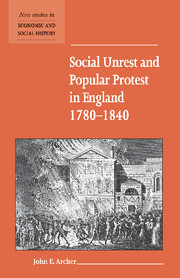Book contents
6 - Policing protest
Published online by Cambridge University Press: 05 July 2015
Summary
In recent years historians have increasingly investigated the obverse side of the riot or ‘contentious gathering’, namely the role, behaviour and response of the authorities. In many respects we have been able to interpret popular gatherings as historical events precisely because the authorities had chosen to intervene in order to placate or suppress the crowd. Moreover, their intervention generally led to either disorder or increased disorder as the very presence of law enforcement agencies could in themselves become an issue of dispute for the crowd. This is especially true during this period when the unofficial and unspoken rules of popular demonstrations, as evinced in food riots, for example, came to be regarded as unacceptable, dangerous and potentially revolutionary by the beleaguered authorities at both central and local government levels.
How authority was exercised in the eighteenth century varied from one region to another, which makes generalisation difficult. However, it is possible to identify an urban–rural dichotomy in which law enforcement became more repressive and less tolerant in towns and cities earlier than in the countryside. But even in the towns the largely amateur magistracy (only the very largest cities had stipendiaries by 1820) had to achieve a delicate balance between law enforcement and social peace, since the former could well upset the latter. In a country which prided itself on not possessing a standing army and having only a rudimentary parish constable system, the wonder is why there was so little disorder. Rioting, as has been shown, was rarely random in its targets nor was it an explosion of anarchic violence; rather it was a selective and limited tactic of redress or negotiation. Such a process suggests that the populace accepted to a large extent ‘the legitimacy of the rule of law’ (Brewer and Styles 1983: 11–20) and the elites whose role it was to rule. The crowd's challenge was therefore set within tightly defined parameters, which were understood by both sides in the dispute.
- Type
- Chapter
- Information
- Social Unrest and Popular Protest in England, 1780–1840 , pp. 75 - 88Publisher: Cambridge University PressPrint publication year: 2000



